1. Introduction
The production of fresh apples in Korea has reached over 508,000 metric tons during 2019-2020 (USDA, 2019). Fuji, hongro, gamhong, yoko, and tsugaru are the major apple cultivars grown in Korea. In recent years, apple growers have increasingly planted alternative and new apple cultivars to satisfy diversifying consumer demand (Yoo et al., 2020a; Yoo et al., 2020b). Among these, the new apple cultivar, ruby-S, is gaining popularity in the apple market because of its high sweetness and quality (Kwon et al., 2019). Although ruby-S is a small apple cultivar, consumers prefer these small-sized apples for daily consumption; therefore, the production of ruby-S has been steadily increasing (Kwon et al., 2019; USDA, 2019). For year-round consumption, the development of storage methods and treatments is required for maintaining apple quality. In general, ruby-S has high storability; however, few reports have been published on the changes in the postharvest quality attributes of this apple cultivar during storage (Kwon et al., 2019).
Apples are climacteric fruits, and their ripening is triggered by ethylene (Bapat et al., 2010). A reduction in fruit quality after harvest and during storage is strongly associated with the ethylene production mechanism (Barry and Giovannoni, 2007; Yoo et al., 2020b). Therefore, 1-methylecyclopropene (1-MCP), an ethylene perception inhibitor, is used to control ethylene production and its activity on climacteric fruits, including apples. However, its effects can vary with cultivar, maturity, concentration, storage conditions, time of application, and experimental conditions (Watkins, 2006; Zhang et al., 2020). In addition, 1-MCP treatment can increase the susceptibility of a few apple cultivars to certain fruit disorders (Watkins, 2008; Watkins et al., 2013). Therefore, it is required to assess the effects of 1-MCP treatment on specific or new apple cultivars to achieve desirable effects.
In general, apples are excellent sources of phenolic and flavonoid compounds, which are antioxidants, and the consumption of antioxidant-rich fruits may prevent chronic and cardiovascular diseases (Boyer and Liu, 2004). In apples, the amounts of phenolic and flavonoid compounds can vary with cultivars and fruit tissues (Kim et al., 2020). In addition, the total phenolic and flavonoid contents and total antioxidant activity are consistently higher in apple peels than in pulp tissues (Kim et al., 2020; Lee et al., 2017), and these activities can be reduced in both tissues during fruit ripening (Kolniak-Ostek et al., 2014; Ma et al., 2019). Moreover, Fawbush et al. (2009) and Lu et al. (2012) reported that the effect of 1-MCP on antioxidant activity was inconsistent during storage, and was highly dependent on the cultivar, storage conditions, and peel or pulp tissue of the fruit. Therefore, this study analyzed the fruit quality changes in 1-MCP-treated ruby-S apples during postharvest cold storage. In addition, changes in the content of fruit nutritional antioxidants, including phenols and flavonoids, as well as total antioxidant activity were also evaluated in apple peels and pulp tissues.
2. Materials and methods
Apples (Malus × domestica Borkh.) were harvested at commercial maturity in an experimental orchard at the Apple Research Institute in Gunwi on August 22, 2017. After harvesting, the fruits were transported to the postharvest laboratory of Kyungpook National University, Daegu, Korea, where they were screened for size uniformity, color, and physical damage. After fruit selection, the fruits were divided into the control (untreated) and 1-MCP treatment groups. Herein, 1 μL/L of 1-MCP (SmartFreshTM, AgroFresh Co., Yakima, USA) was selected as the recommended apple fruit treatment concentration, according to Yoo et al. (2020a) and Zhang et al. (2020). For 1-MCP treatment, the fruits were fumigated with 1-MCP gas in an enclosed container for 18 h at 20°C (Win et al., 2021b). The control group was stored at 20°C without 1-MCP treatment. The fruits were then stored at 0±1°C and 90±5% relative humidity for 6 months. The fruit quality parameters and antioxidant activity were analyzed after 0 (harvest), 3, and 6 months of storage.
Fruit quality parameters [fruit weight loss, internal ethylene concentration (IEC), fruit skin greasiness, fruit peel color variables, flesh firmness, soluble solids content (SSC), and titratable acidity (TA)] were assessed in 15 individual fruits from each treatment group. First, the fruits were individually weighed throughout the storage period using a digital scale (AND Co., Daejeon, Korea). Differences in fruit weight before and after storage were recorded as fruit weight loss (Kim et al., 2018). To determine the IEC, a hypodermic needle (a stainless steel 18-gauge 3.8 cm long) was inserted into the core cavity through the calyx end of the apple fruit, and 1 mL of the internal gas was injected into a syringe through the needle. The sample gas was then inserted into a gas chromatograph (GC-2010 Shimadzu Co., Kyoto, Japan) fitted with a flame ionization detector and Porapak Q column (80/200 2-m, Young In Frontier Co., Seoul, Korea) (Yoo et al., 2021). During the IEC measurements, the oven temperature was set at 90°C, whereas those of the injector and detector were maintained at 200°C. The level of fruit skin greasiness was determined using a slightly modified score test (0-3 scores), according to Yang et al. (2017a), where 0=no greasiness, 1=slight greasiness, 2=moderate greasiness, and 3=severe greasiness. Changes in fruit peel color were determined on the sunlit side area of the fruit using the CIE L*, a*, b* system with a colorimeter (CR-200, Konica Minolta Co., Tokyo, Japan) (Kim et al., 2018). Flesh firmness (11 mm plunger) was determined at three locations around the equatorial regions of each fruit using a firmness tester (Compac-100II, Sun Scientific Co., Tokyo, Japan). The juice from each fruit was used to determine SSC and TA. SSC was determined using a digital refractometer (PR-201α, Atago Co., Tokyo, Japan) with a refractive index accuracy of ±0.1 and a range of 0-45% with temperature correction. The average of the SSC values from the three marked positions was used as the final reference values of the tested sample. The TA was determined using the juice with 0.1 M NaOH to an endpoint of pH 8.1 (Win et al., 2019). After the assessment, 10 g of each apple peel and pulp tissue was frozen and stored at −80°C for further antioxidant activity analysis.
The total phenolics content (TPC), total flavonoids content (TFC), and antioxidant activity were determined according to the method of Win et al. (2021a). First, 10 g of frozen tissue samples (peel and pulp) was ground with 100 mL of 80% acetone. The extracted residue was filtered through No. 541 filter paper (Whatman International Ltd., Kent, England), and the filtrate was evaporated using a Labconco rotary evaporator (N-1000, Rikakikai Co., Tokyo, Japan) at 45°C. The samples were then brought to a volume of 10 mL with distilled water and stored in a cold chamber until analysis.
The TPC in apple peels and pulp tissues was measured as described by Win et al. (2021a). The sample extract (0.2 mL) was mixed with 0.2 mL of Folin-Ciocalteu reagent (Sigma Aldrich Co., St. Louis, MI, USA). Next, 0.2 mL of 7% Na2CO3 and 2.6 mL of distilled water were added to the mixture. The reaction was allowed to proceed for 2 h at 25°C and the absorbance was measured at 750 nm using a UV spectrometer (UV-1800, Shimadzu Co., Tokyo, Japan) with a blank (distilled water). A blank was used to adjust the instrument to an optical density of zero. TPC was estimated using a gallic acid standard curve (dilutions of 0.1, 0.5, 1.0, 2.5, and 5 mg/mL in distilled water), and the unit was expressed as g/kg (fresh weight).
The TFC in the apple peels and pulp tissues was measured as described by Win et al. (2021a). The sample extract (1 mL) was then diluted with distilled water (4 mL). Then, 0.3 mL of 5% NaNO2, 0.3 mL of 10% AlCl3, 2 mL of 1 M NaOH, and 2.4 mL of distilled water were added. The absorbance was measured at 510 nm using a blank (distilled water). The TFC was estimated using a catechin standard curve (dilutions of 0.1, 0.5, 1.0, 2.5, and 5 mg/mL in distilled water), and the unit was expressed as g/kg (fresh weight).
The antioxidant activity in apple peel and pulp tissues was measured using the 1,1-diphenyl-2-picrylhydrazyl (DPPH) radical scavenging assay, as described by Ma et al. (2019). A mixture of the sample extract (2 mL) and 2 mL of 0.2 mM DPPH ethanol solution (2 mL) was incubated in the dark for 30 min. The absorbance was measured at 517 nm using a blank containing 95% ethanol. DPPH radical scavenging activity (RSA) was determined using the following equation:
where ABSsample is the absorbance of the sample extract and ABSblank is the absorbance of the blank.
SPSS statistical software (version 25; IBM SPSS Corp., NY, USA) was used for all analyses. Analysis of variance was applied to all data, and the significant differences in mean values between the control and 1-MCP treatments were evaluated using Student’s t-test at *p<0.05, and **p<0.01.
3. Results and discussion
Weight loss in fruits increased in both the control and 1-MCP treatment groups. In this study, 1-MCP did not decrease the weight loss of ruby-S apples during storage (Fig. 1(A)). In general, fruit weight loss is associated with fruit respiration and transpiration rate (Win et al., 2021a). In addition, few studies have reported that the effect of 1-MCP on fruit weight loss is highly dependent on the cultivar, storage conditions, and concentration (Kwon et al., 2021; Win et al., 2019; Yoo et al., 2021). However, a concentration of 1 μL/L 1-MCP was used in this study; therefore, the lacking effect of 1-MCP on weight loss might be due to differences in cultivar or storage conditions.
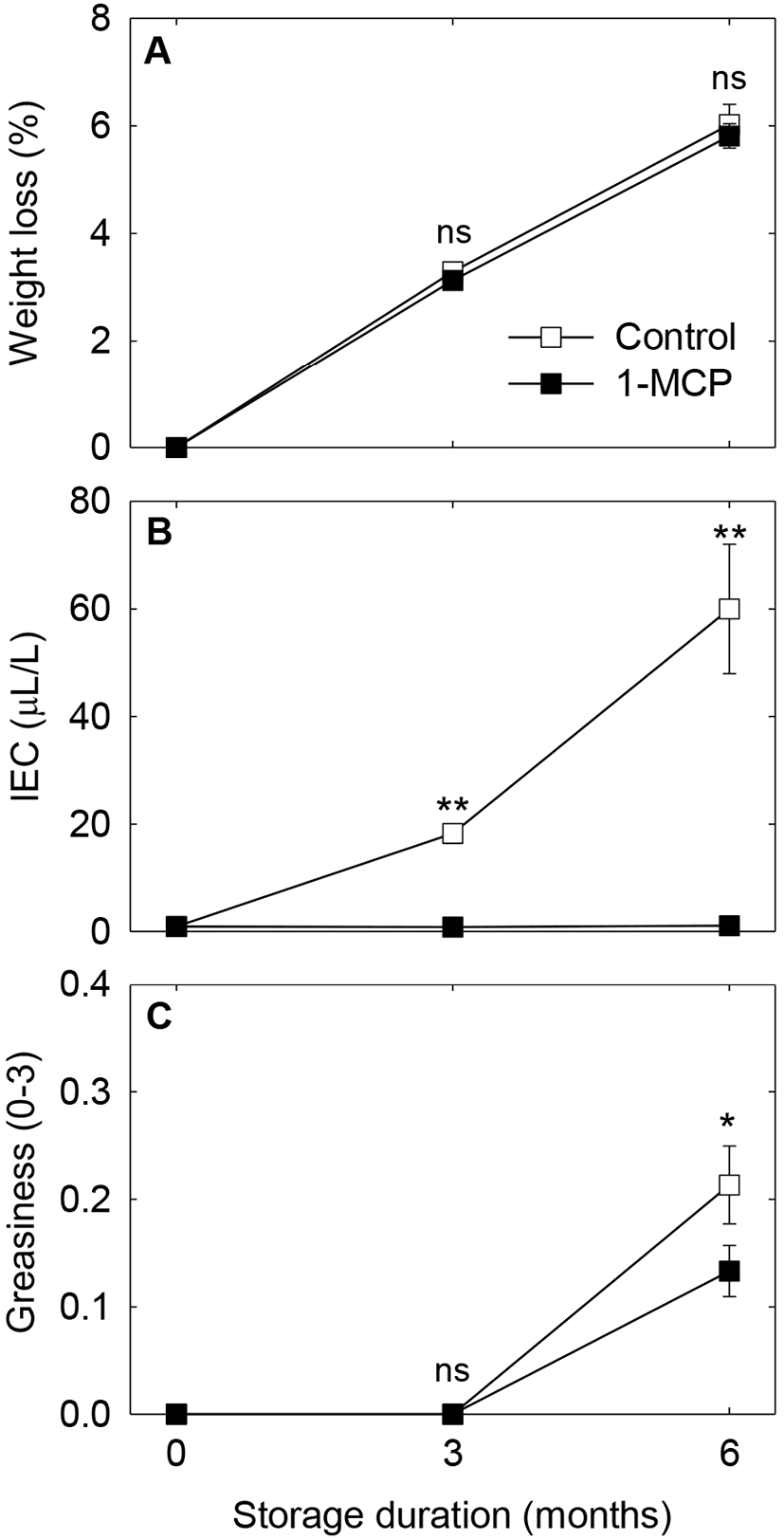
A significant increase in IEC was observed in the control fruit throughout the storage period, whereas it was inhibited in the 1-MCP-treated fruit (p<0.01, Fig. 1(B)). Climacteric fruits generally produce large amounts of ethylene during ripening (Bapat et al., 2010). In apples, IEC is considered an indicator of the maturity index, because an increase in IEC level is associated with the climacteric ripening stage of the fruit (Jung and Watkins, 2014). Ethylene production in apples is associated with the activities of 1-aminocyclopropane-1-carboxylic acid (ACC) synthase (ACS) and ACC-oxidase (ACO) enzymes in the ethylene biosynthesis pathway (Jung and Watkins, 2014). The enzyme activities of ACS and ACO and their expression levels are reduced in fruits when 1-MCP blocks ethylene perception at the receptor sites (Jung and Watkins, 2014; Wakasa et al., 2006; Yang et al., 2013). The inhibition of IEC by 1-MCP has also been reported in numerous apple cultivars (Win et al., 2021b; Yoo et al., 2020a; Yoo et al., 2020b; Yoo et al., 2021; Zhang et al., 2020).
Fruit greasiness occurred in both treatments after six months of storage and was higher in the control fruit than in the 1-MCP-treated fruit (p<0.05, Fig. 1(C)). Fruit greasiness is generally observed in stored apples during ripening. In addition, the occurrence of fruit greasiness is related to changes in wax constituents and the structure of fruit skin (Yang et al., 2017a; Yang et al., 2017b). The inhibition of 1-MCP on fruit greasiness in apples has been previously reported (Yang et al., 2017a).
Flesh firmness decreased in both treatments during storage; however, 1-MCP decelerated the decrease in flesh firmness compared with that of the untreated control fruit (p<0.01, Fig. 2(A)). Similar observations were also made in the case of TA (p<0.01, Fig. 2(B)). Unlike flesh firmness and TA, the SSC increased in both treatments during storage. However, the SSC did significantly differ between untreated and 1-MCP-treated fruits throughout the storage period (p>0.05, Fig. 2(C)).
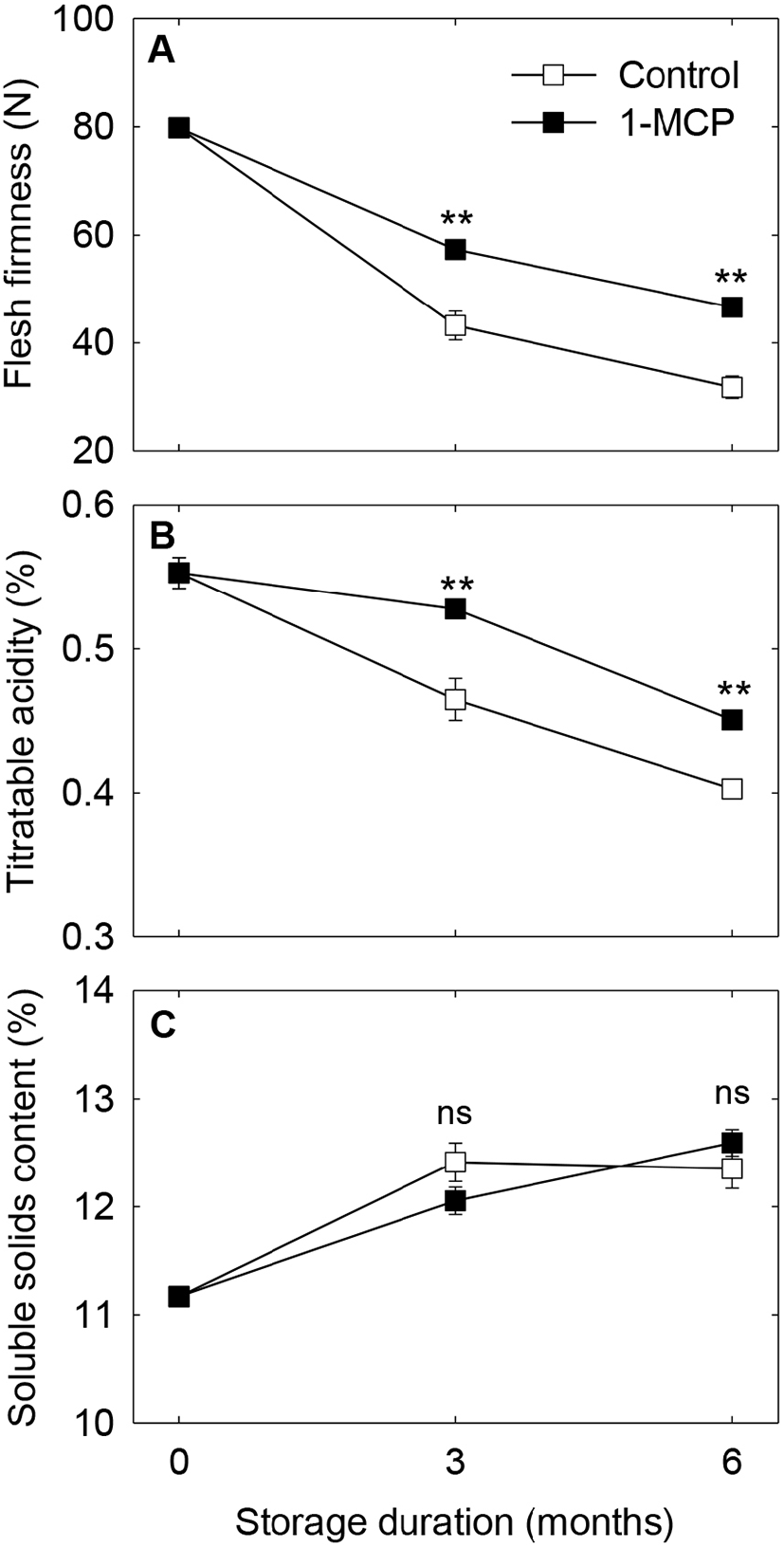
Apple quality attributes generally include wide-ranging external and internal attributes, and fruit texture, acidity, and sweetness are determined as internal quality attributes (Musacchi and Serra, 2018). The reduction in flesh firmness is a result of fruit softening caused by the degradation of the fruit cell wall texture (Win et al., 2021b). The 1-MCP treatment delays the degradation of fruit cell wall texture and softening in apples (Win et al., 2019; Win et al., 2021b; Yoo et al., 2021), as observed in this study. Yoo et al. (2021) reported that firmness and TA are positively correlated, and these attributes generally decrease during fruit ripening, particularly in untreated fruits. The SSC generally increases during ripening because of an increase in fruit starch degradation (Kader, 2008). In addition, an increase in SSC is associated with a decrease in TA (Yoo et al., 2021). The response of SSC to 1-MCP varies depending on the cultivar used (Watkins et al., 2006). Win et al. (2019) also reported that 1-MCP affected the SSC only in green ball but not in the summer king apples during cold storage. In this study, we observed that 1-MCP did not affect the SSC of ruby-S during storage.
Peel color attributes (L*, a*, and b*) were determined on the sunlit side of apples during storage (Fig. 3). The 1-MCP treatment maintained a reduction in peel color attributes, particularly in L* and b* values, after six months of storage (p<0.01, Fig. 3(A), (C)), but did not affect the a* value (Fig. 3(B)). In the apple market, the fruit peel color is considered an external quality attribute, and poorly colored fruits are less demanding in terms of marketability and consumer acceptability (Musacchi and Serra, 2018). Therefore, apple fruit color was examined as an indicator of fruit maturity, and the reduction in peel color attributes during storage was determined to be a characteristic of fruit ripening (Kim et al., 2018). The 1-MCP treatment can decelerate the reduction in peel color intensity but can vary with cultivar, storage conditions, and concentration (Watkins, 2006; Zhang et al., 2020). In addition, L* and b* values exhibit similar trends and are positively correlated during ripening (Kim et al., 2018). Similarly, in this study, reductions in L* and b* values were observed in both treatments, but 1-MCP helped decelerate this reduction during ripening.
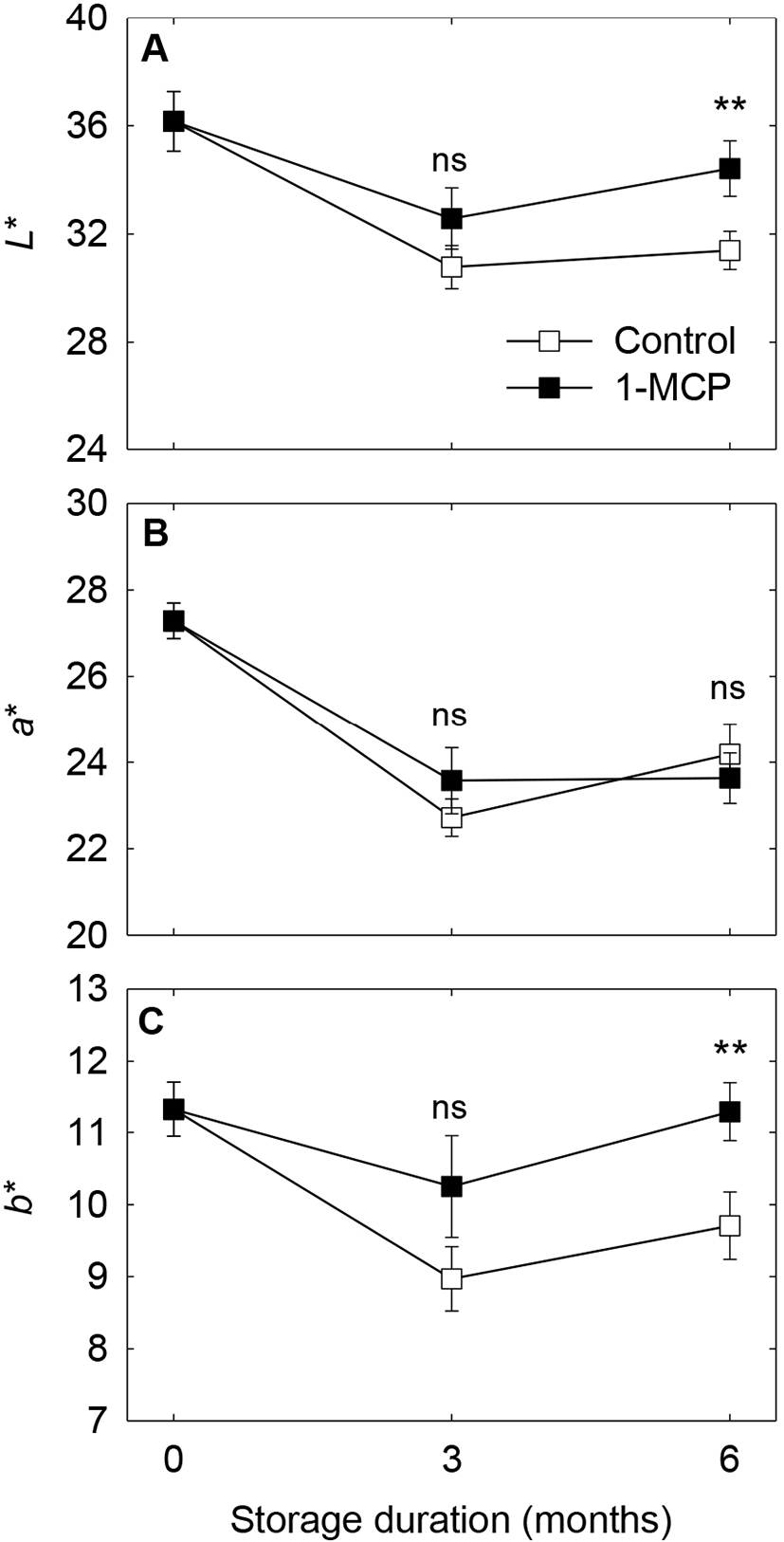
The TPC and TFC and total antioxidant (determined DPPH radical scavenging assay) activities were determined in both the apple peel and pulp tissues (Fig. 4, 5). The TPC, TFC, and DPPH scavenging activities were reduced in both peel and pulp tissues during storage. The 1-MCP treatment decelerated the reduction in TPC, TFC, and DPPH activities in peel tissue (p<0.01, Fig. 4(A)-(C)). In the pulp tissue, 1-MCP affected only TPC (p<0.05, Fig. 5(A)) and 1-MCP did not affect TFC or DPPH activity (Fig. 5(B), (C)). In general, the TPC, TFC, and antioxidant activities were higher in apple peels than in the pulp (Lee et al., 2017; Ma et al., 2019; Wolfe et al., 2003), as observed in this study. Depending on the apple cultivar, approximately 20-30% of TPC can be reduced during fruit ripening (Kolniak-Ostek et al., 2014). In addition, Piretti et al. (1996) reported that the degradation of phenolic, flavonoid, and antioxidant activities of apples during storage may be a result of the attack by reactive oxygen species or the polymerization of monomeric phenolic compounds. Reductions in TPC, TFC, and DPPH activities during storage were also reported in the jonagold apple (Ma et al., 2019).
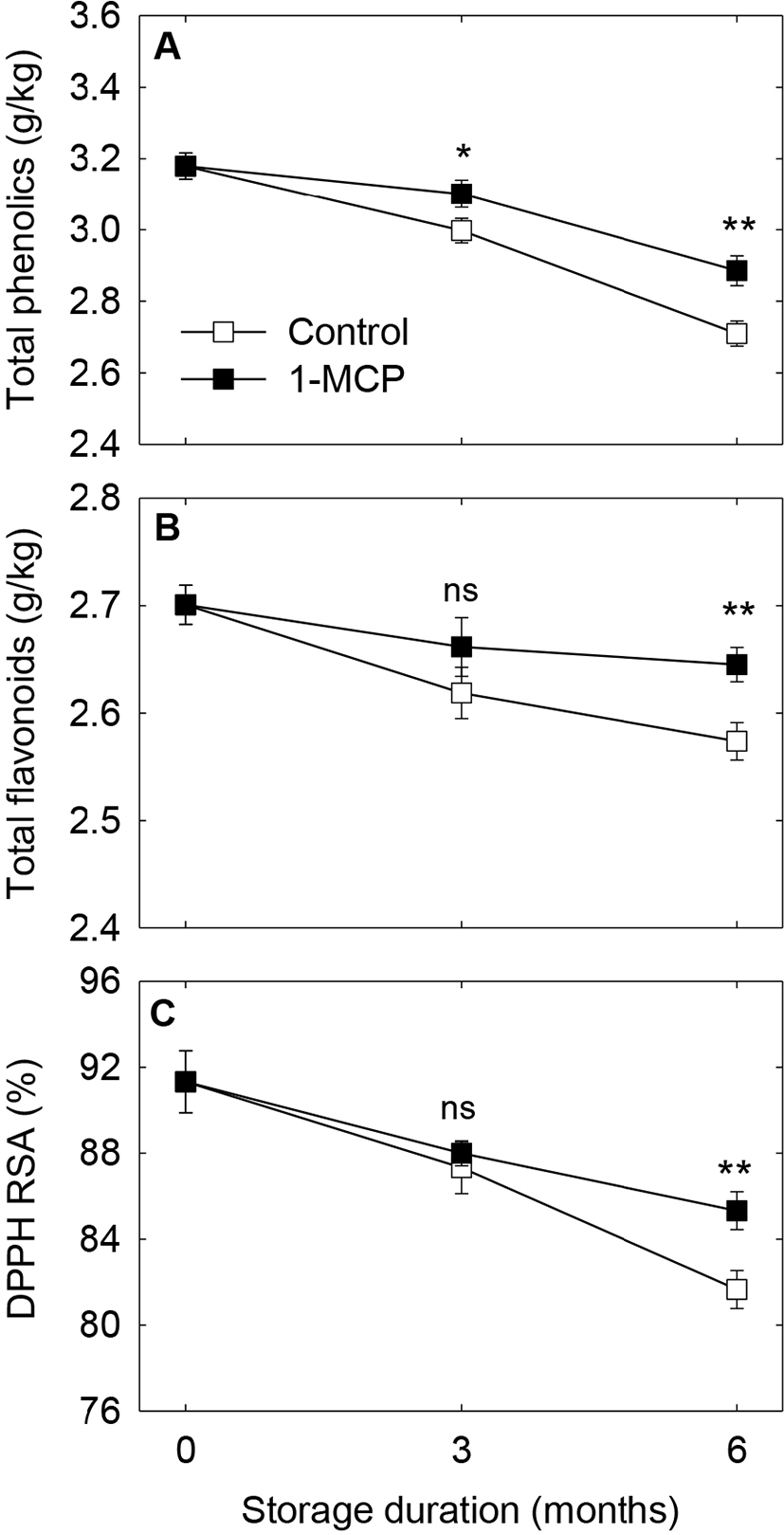
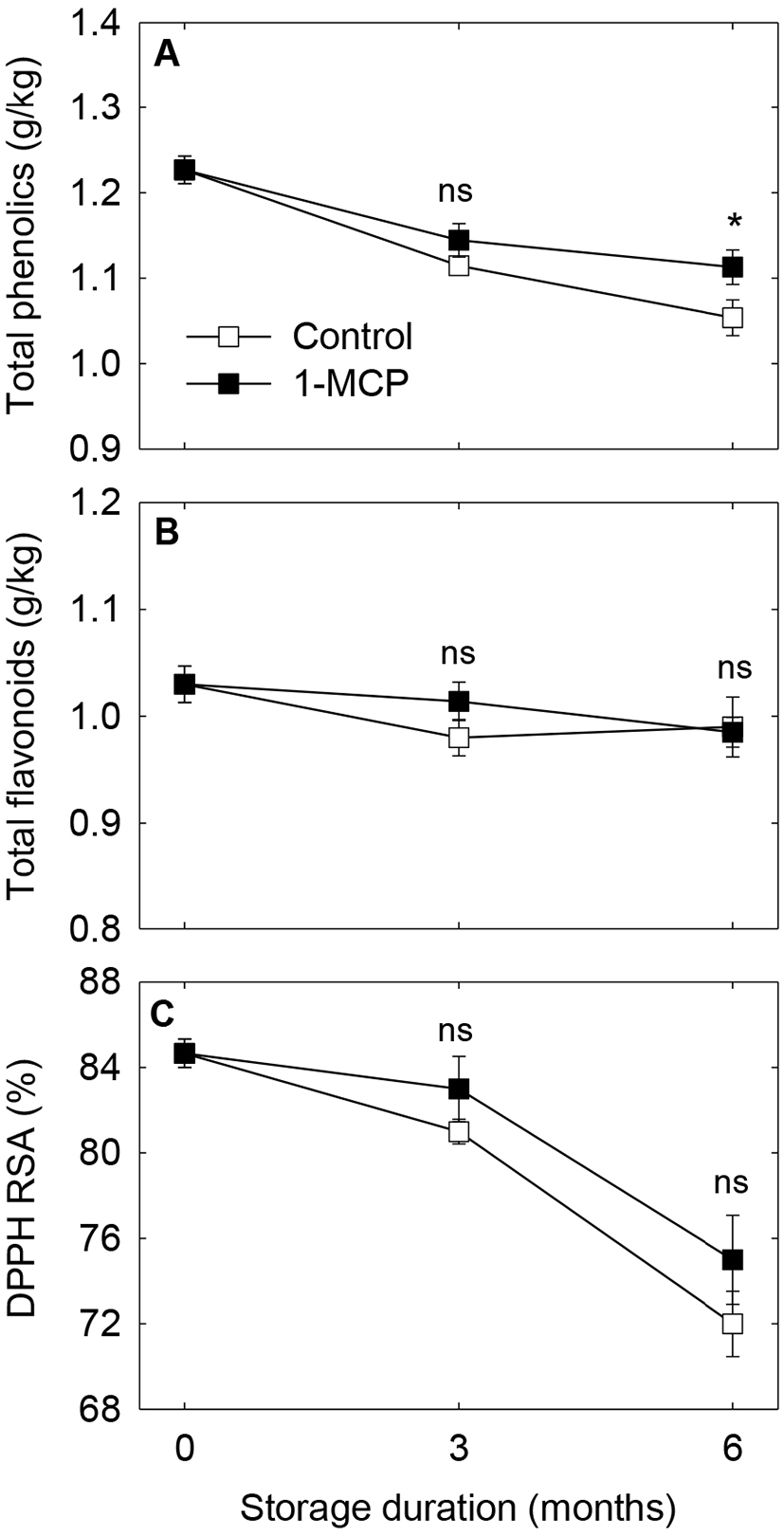
In general, 1-MCP treatment can help lower the reduction in TPC, TFC, and antioxidant activity during apple fruit ripening (Kolniak-Ostek et al., 2014; Lee et al., 2017; Ma et al., 2019). Lu et al. (2012) reported that the TPC, TFC, and antioxidant activity were considerably affected by 1-MCP in the peel tissue but not in the pulp tissue of cold-stored fuji apples harvested at different maturity stages. In the empire apple, 1-MCP affected the TPC, TFC, and antioxidant activity more in the peel than in the pulp tissues during controlled atmosphere storage (Fawbush et al., 2009). Hoang et al. (2011) reported the different effects of 1-MCP on phenolic compounds and antioxidant activity in the peel and pulp of apples. Moreover, MacLean et al. (2006) reported that the 1-MCP treatment helped maintain higher levels of flavonoids in the peel of Red Delicious apples. In this study, 1-MCP affected the TPC, TFC, and antioxidant activity in peel tissue but not in pulp tissue (particularly TFC and DPPH RSA). Therefore, the response of the TPC, TFC, and antioxidant activity to 1-MCP could also vary depending on the cultivar, maturity, storage conditions, storage duration, and determination methods of antioxidant activity (Ma et al., 2019).
4. Conclusions
During apple ripening, the untreated control fruit produced large amounts of IEC. During the ripening of the untreated fruit, fruit weight loss and SSC increased, whereas flesh firmness and TA decreased. In addition, fruit greasiness occurred in apple peel during ripening. Moreover, peel color attributes and antioxidant activity were decreased during ripening in the untreated fruit. After 1-MCP treatment, the fruit maintained flesh firmness and TA and showed reduced IEC and fruit greasiness during ripening. However, 1-MCP affected antioxidant activity more in the apple peel tissue than in the pulp tissue, and 1-MCP did not affect the fruit weight loss, SSC, or a* value. Therefore, this study demonstrates that 1-MCP helps extend the storability of ruby-S apples, but its effects on the TPC, TFC, and antioxidant activity may vary in the peel and pulp tissues of the fruit.
